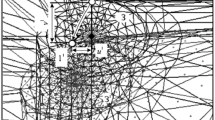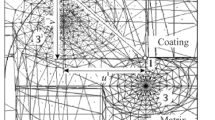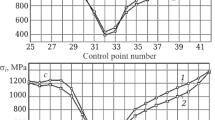The effect of a coating on stress structural inhomogeneity in ceramic is studied. A research procedure is created based on an automatic system of thermal strengthening calculations for ceramic plates.
Similar content being viewed by others
Avoid common mistakes on your manuscript.
Introduction
Instability of operating properties of objects made from ceramic materials under extreme external action conditions suggests development of special methods for improving their reliability [1, 2]. A promising area for resolving this practical task is application of functional coatings on ceramic objects [3]. A combination of favorable effects has been achieved and described in detail in [4]. However, complication of the structure of a surface layer of a heterophase system leads to a marked change in its stress-strained state [5]. In individual cases this leads to defect formation at phase boundaries, and this has a very unfavorable effect on ceramic component operating efficiency [6]. Therefore the fact of defect development requires special attention in choosing coatings or a special approach to effective design of ceramic objects with functional coatings [7].
Design of ceramic components, at whose surface presence of functional coatings is proposed, is a complicated task. As a rule during its solution primary attention is devoted to fulfilling functional requirements for a coating [8]. The whole “horizon of possible problems” has not been analyzed adequately, in particular the effect of a selected functional coating on behavior of the “basic” ceramic, which is very demanding for operating conditions, and correspondingly loading.
Different loads form l special stress-strained states in ceramic material [9–13]. This specific nature predetermines features of material degradation and failure. Examples have been demonstrated in this respect for use of ceramic tool coatings [14, 15]. For example, with one of the operating regimes a coating provides a manifold increase in ceramic tool life, and in other an unfavorable effect is observed. This occurs on a general background of fulfilling basic requirements for a functional coating. Other examples exist of an ambiguous effect of functional coatings on ceramic object operating indices.
The reason for an ambiguous effect of functional coatings on operating properties of ceramic objects has not so far been established. Therefore revelation of the nature of this effect is an important scientific and practical task, whose solution will make it possible to plan effectively ceramic composite systems for specific fields of application. In order to resolve the problem a set of studies has been carried out for the effect of coatings on structural stress inhomogeneity in ceramics under action of different external loads. The results obtained will be presented in future publications.
The present article considers features of the stress-strained state of structural elements of oxide-carbide ceramic without and with a coating of titanium nitride under action of a concentrated force.
Research Procedure
Experimental study of the structural stress inhomogeneity in ceramic, by which we understand a change in stresses σ11, σ22, σ12, and stress intensity σi at a surface (in a surface layer) of structural ceramic elements under action of an external load, is almost impossible due to their small dimensions. Therefore in order to resolve this task numerical modeling was used for deformation processes of a structurally inhomogeneous medium.
On the basis of results of studying the structure of a VOK71 ceramic plate with a TiN coating using a VEGA 3 LM Tescan scanning electron microscope, its microstructural model was plotted. Assumptions provided in [16] were used for guidance. The model describes an inhomogeneous layered medium, and consists of the following ceramic structural elements (Fig. 1): a grain, intergranular phase, coating, and contact metal. A design layout was formulated on the basis of this model with the following assumptions: 1) a plane problem is considered, 2) ceramic is an inhomogeneous and defect-free material, 3) coating and metal are uniform and defect-free materials, 4) there is no plastic strain.
The design layout (Fig. 2) is presented in the form of a structure consisting of uniform structural elements: grains of ellipsoidal shape and size a = 2 μm, b = 3 μm, which are fixed in a matrix through intergranular phase with thickness δ f = 0.2 μm. At the outer side of a grain, intergranular phase, and matrix, there are successively placed coatings layers Δc thick and gray cast iron with thickness Δc =2 μm thick. With Δc = 0 μm the structure in question is uncoated, but with Δc = 5 μm it is a structure with a coating. Calculations were carried out for a construction, determined by the following parameters: n1 = 6, n2 = 6, n3 = 6, n4 = 4, c = 2.5, which are used with automatic generation of finite elements in a design layout.
In a model of a titanium carbide TiC grain (density ρ = 4.9 g/cm3, elasticity modulus E = 484 GPa, Poisson’s ration μ = 0.22, linear thermal expansion coefficient α = 7.95 × 10–6K–1); intergranular phase of magnesium oxide MgO (ρ = 3.4 g/cm3, E = 315 GPa, μ = 0.18, α = 13.4 × 10–6 K–1), uniformly distributed over the outer grain contour; ceramic matrix of aluminum oxide Al2O3 (ρ = 5.68 g/cm3, E = 180 GPa, μ = 0.2, α = 8.5 × 10–6 K–1); titanium nitride TiN coating layer (ρ = 5.44 g/cm3, E = 440 GPa, μ = 0.25, α = 9.3 × 10–6 K–1), and layer of gray cast iron SCh32 (ρ = 5.68 g/cm3, E = 180 GPa, μ = 0.2, α = 10.5 × 10–6 K–1). Thermal conductivity λ, W/(m·deg) of materials prescribed by equations λ = 23.2e 0.0002T, λ = 7871.2/(T – 125) + 3.6 × 10–33 T 10, λ = 2100T –0.78, λ = 36.6e 0.00045T, and λ = 44.028e –0.0005T for TiC, MgO, Al2O3, TiN, and SCh32 respectively. A complete list of reference books from which the values of these indices were taken are provided in [17].
In future a construction without a coating will be called the system (TiC–MgO–Al2O3)–SCh32, and a construction with a coating will be called the system (TiC–MgO–Al2O3)–TiN–SCh32.
Concentrated force F was applied to a free surface of a construction in the design layout, operating on its radius section at angle β = 45°, and also distributed force P and heat flux Q, which operate on sections with length l 1 and l 2. From surfaces free from a heat flux, heat removal was provided into the surroundings with a constant coefficient h = 105 W(m2·deg).
Numerical experiments were carried out in an automated RKS-ST v.1.0 thermal-strength calculation system [17]. In order to analyze results of numerical experiments a method of control points (CP) was used by which we understand fixed finite elements of a construction [18]. The number and positions of CP were determined taking account of the aim of the present study. A fragment of an actual finite element network with CP labelling is shown in Fig. 3. All of the selected CP are arranged in the surface layer of a grain (CP1 – CP24), intergranular phase adjacent to a grain (CP25 – CP42), intergranular phase, adjacent to matrix (CP43 – CP60), and matrix adjacent to intergranular phase (CP61 – CP78). Stresses in coating layers and metal were not separated and not studied in the research. After performing calculations values of stresses σ11, σ22, σ12, and stress intensity σ i \( \left({\upsigma}_i=\sqrt{\upsigma_{11}^2{\upsigma}_{11}{\upsigma}_{22}+{\upsigma}_{22}^2+4{\upsigma}_{12}^2}\right) \) in each CP were obtained. Results of calculations were presented in the form of temperature and stress fields, and also curves connecting numerical stress values with CP position. For a quantitative estimate of the structure of stress inhomogeneity in each surface layer of an element of ceramic structure the following indices were used: maximum σmax (greatest value of tensile stresses), minimum σmin (least value of compressive stresses, and average σav values of stresses σ11, σ22, σ12, and σi, range of change in stress (taking account of their sign), number of changes in stress sign, and also their standard deviation s.
Conclusion
The procedure developed on the basis of an automated system of thermal-strength calculations for ceramic plates makes it possible to study stress inhomogeneity in ceramic structural elements.
References
A. G. Evans and T. G Langdon, Structural Ceramics [Russian translation], Metallurgiya, Moscow (180).
V. L. Balkevich, Engineering Ceramics, Higher education textbook, 2nd, ed. [in Russian], Stroizdat, Moscow (1984).
V. K. Starkov, V. V. Kuzin, V. F. Popov, et al., “Increase in operating properties for ceramic material objects by mechanical and heat treatment,” Engineering Production. Series Progressive Production Processes in Engineering, Review, VNII-TÉMP (1989).
S. N. Grigor’ev and M. A. Volosova, “Engineering of a metal cutting tool surface by combined vacuum-plasma treatment (Part 1),” Remont. Vosstanov. Modern., No. 7, 2 – 6 (2004).
S. N. Grigor’ev, V. V. Kuzin, and M. A. Volosova, “Stress-strain state of a coated nitride ceramic tool,” Rus. Eng. Res., 32(7/8), 561 – 566 (2012).
Yu. L. Krasulin, S. N. Barinov, and V. S. Ivanov, Structure and Failure of Materials Made of Refractory Compound Powders [in Russian], Nauka, Moscow (1985).
V. V. Kuzin, “Procedural approach to improving the operating efficiency of ceramic tools,” Vestn. Mashinostroeniya, No. 9, 87 – 88 (2006).
A. S. Vereshchaka and V. V. Kuzin, “Composite coatings as a factor for improving tool operating efficiency and reliability,” in: Methods for Improving Productivity and Quality of Machined Components in Automated Production Equipment, Proc. Sci.-Tech. Conf, Yaroslavl (1985).
V. V. Kuzin, S. N. Grigor’ev, and V. N. Ermolin, “Stress inhomogeneity in a ceramic surface layer under action of an external load. Part 1. Effect of complex mechanical loading,” Refr. Indus. Ceram., 54, No. 5, 416 – 419 (2014).
V. V. Kuzin, S. N. Grigor’ev, and V. N. Ermolin, “Stress inhomogeneity in a ceramic surface layer under action of an external load. Part 2. Effect of thermal loading,” Refr. Indus. Ceram., 54(6), 497 – 501 (2014).
V. V. Kuzin, S. N. Grigor’ev, and V. N. Ermolin, “Stress inhomogeneity in a ceramic surface layer under action of an external load. Part 3. Effect of a distributed force load,” Refr. Indus. Ceram., 55(1), 36 – 39 (2014).
V. V. Kuzin, S. N. Grigor’ev, and V. N. Ermolin, “Stress inhomogeneity in a ceramic surface layer under action of an external load. Part 4. Combined effect of force and thermal loads,” Refr. Indus. Ceram., 55(1), 40 – 44 (2014).
S. N. Grigor’ev, V. V. Kuzin, M. N. Morgan, et al., “Influence of loads on the stress-strain state of aluminum-oxide ceramic cutting plates,” Rus. Eng. Res., 32(1), 61 – 67 (2012).
V. V. Kuzin, “Development and study of cutting tools of silicon nitride with a coating,” Trakt. Sel’sk. Mashiniy, No. 9, 48 – 52 (2006).
M. A. Volosova and S. N. Grigor’ev, “Production principles of depositing wear-resistant nano-coatings for use in tool manufacture,” Uproch. Tekhnol. Pokrytiya, No. 6, 37 – 42 (2010).
V. V. Kuzin, “Microstructural model of ceramic cutting plate,” Rus. Eng. Res., 31(5), 479 – 483 (2011).
S. N. Grigor’ev, V. I. Myachenkov, and V. V. Kuzin, “Automated thermal-strength calculations of ceramic cutting plates,” Rus. Eng. Res., 31(11), 1060 – 1066 (2011).
V. Kuzin and S. Grigoriev, “ Method of investigation of the stress-strain state of surface layer of machine elements from a sintered nonuniform material,” Appl. Mechan. Mater., 486, 32 – 35 (2014).
The article was prepared with support of the Russian Ministry of science in fulfilling research work within the framework of a state assignment.
Author information
Authors and Affiliations
Corresponding author
Additional information
Translated from Novye Ogneupory, No. 8, pp. 28 – 31, August 2014.
Rights and permissions
About this article
Cite this article
Volosova, M.A., Grigor’ev, S.N. & Kuzin, V.V. Effect of Tinaium Nitride Coatings on Stress Structural Inhomogeneity in oxide-carbide ceramic. Part 1. Research Procedure. Refract Ind Ceram 55, 338–340 (2014). https://doi.org/10.1007/s11148-014-9722-z
Received:
Published:
Issue Date:
DOI: https://doi.org/10.1007/s11148-014-9722-z







